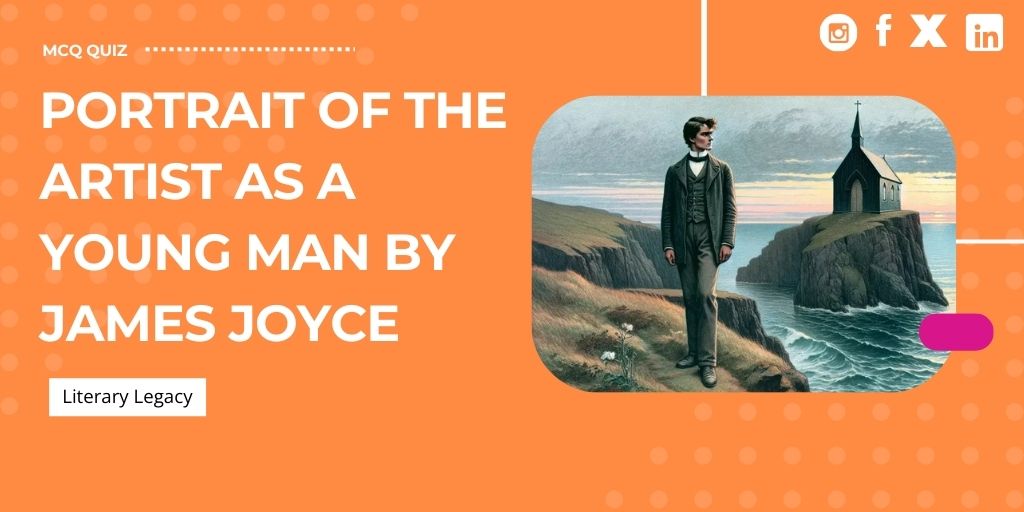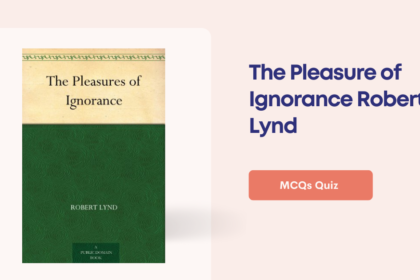1. What is the character trait that Stephen exhibits when he confides in Cranly?
Choices
A) Comfort in social settings
B) Apathy towards relationships
C) Openness to criticism
D) Desire for companionship
Answer: (D)
Desire for companionship
Stephen’s willingness to share his inner thoughts with Cranly reflects his desire for companionship despite his acceptance of loneliness.
2. How does the dean of studies’ preference for moral beauty compared to Stephen’s views characterize their philosophical differences?
Choices
A) The dean values traditional teachings over modern theories
B) Both prioritize intellectual beauty above all else
C) Stephen seeks emotional resonance while the dean favors pragmatism
D) Stephen’s views lack foundation, according to the dean
Answer: (C)
Stephen seeks emotional resonance while the dean favors pragmatism
The contrast highlights Stephen’s focus on aesthetic and emotional depth versus the dean’s more practical and straightforward approach.
3. What does Nash’s taunting reveal about his character and relationship with Stephen?
Choices
A) He is deeply insecure and compensates by bulling
B) He respects Stephen’s choice of literary preference
C) He seeks to elevate his own status among their peers
D) He admires Stephen’s intelligence
Answer: (A)
He is deeply insecure and compensates by bulling
Nash’s bullying behavior is often a reflection of his own insecurities, suggesting a deeper layer to their interactions.
4. Which aspect of Stephen’s character does his reaction to Johnny Cashman’s humor reveal?
Choices
A) A strong sense of loyalty to friends
B) An aversion to trivializing family heritage
C) A profound sensitivity to criticism
D) A deep appreciation for humor
Answer: (B)
An aversion to trivializing family heritage
Stephen’s disgust towards Cashman’s portrayal of his family highlights his strong feelings about the importance of heritage and respect.
5. What does MacCann’s view of Stephen as an egocentric elitist suggest about their ideological conflict?
Choices
A) MacCann seeks to diminish artistic aspirations
B) Stephen prioritizes personal satisfaction above social responsibility
C) MacCann believes in individualism over collective action
D) Stephen favors social conformity over personal beliefs
Answer: (B)
Stephen prioritizes personal satisfaction above social responsibility
MacCann’s perception illustrates the tension between individual advocacy for art and the demands of social obligations.
6. What does Stephen recall while listening to his father’s fairy tale as an infant?
Choices
A) A dream about school
B) His father’s childhood
C) Memories of his governess
D) The sound of the candy seller
Answer: (C)
Memories of his governess
Stephen’s thoughts drift to various people in his life, including the candy seller and his governess Dante.
7. What event does Stephen learn about while he is in the infirmary?
Choices
A) The opening of a new school
B) The arrival of a new teacher
C) The death of a prominent Irish nationalist
D) The announcement of holiday plans
Answer: (C)
The death of a prominent Irish nationalist
While in the infirmary, Stephen hears about the death of Parnell, a significant event in Irish history.
8. What issue causes conflict during Stephen’s family holiday gathering?
Choices
A) Educational disagreements
B) A political debate over Parnell
C) A tradition of gift giving
D) Financial difficulties
Answer: (B)
A political debate over Parnell
Stephen’s family engages in a bitter argument regarding Parnell and his relationship with the Catholic Church.
9. What feeling does Stephen experience after complaining to the rector?
Choices
A) Sadness and isolation
B) Relief and support from peers
C) Anger towards authority
D) Excitement and confidence
Answer: (B)
Relief and support from peers
After receiving support from the rector, Stephen feels cheered by his schoolmates.
10. Which book does Stephen read during his summer in Blackrock?
Choices
A) Pride and Prejudice
B) The Count of Monte Cristo
C) The Great Gatsby
D) Moby Dick
Answer: (B)
The Count of Monte Cristo
Stephen reads The Count of Monte Cristo during the summer while exploring Blackrock.
11. What does Stephen’s family face that leads to moving to Dublin?
Choices
A) A health crisis
B) A family dispute
C) Financial troubles
D) A job opportunity
Answer: (C)
Financial troubles
Stephen’s family experiences financial difficulties which force them to relocate to Dublin.
12. What type of essays gets Stephen into trouble at Belvedere?
Choices
A) Heretical essays
B) Historical essays
C) Biographical essays
D) Romantic essays
Answer: (A)
Heretical essays
At Belvedere, Stephen writes faintly heretical essays that cause conflict with teachers and friends.
13. What causes Stephen restlessness and unhappiness at the end of the year?
Choices
A) Poor academic performance
B) Loss of a friend
C) Spending a prize money too quickly
D) Conflict with family
Answer: (C)
Spending a prize money too quickly
After receiving a large sum of money for his academic performance, Stephen quickly spends it on friends and family leading to restlessness and unhappiness.
14. What causes Stephen to initially seek a more pious lifestyle?
Choices
A) Confession after a personal awakening
B) Influence from friends
C) Religious retreat lectures
D) The director’s suggestion
Answer: (C)
Religious retreat lectures
Stephen’s guilt intensifies after attending a religious retreat with powerful lectures.
15. What realization does Stephen come to regarding the priesthood?
Choices
A) It is what society expects from him
B) It is a calling meant for him
C) It provides a fulfilling life
D) He finds it repulsive and boring
Answer: (D)
He finds it repulsive and boring
Stephen rejects the idea of a priestly life, finding it unappealing.
16. Which genre best describes A Portrait of the Artist as a Young Man?
Choices
A) Künstlerroman and Bildungsroman
B) Mystery novel
C) Historical fiction
D) Science fiction
Answer: (A)
Künstlerroman and Bildungsroman
The novel can be classified as both a Künstlerroman and a Bildungsroman.
17. How does Joyce depict Stephen’s adolescent struggles?
Choices
A) Through a first-person narrative
B) By detailing other characters’ experiences
C) Through interactions with society only
D) Using a stream-of-consciousness technique
Answer: (D)
Using a stream-of-consciousness technique
Joyce employs a stream-of-consciousness narrative to convey Stephen’s internal struggles.
18. What term does Joyce use to describe Stephen’s moments of profound insight?
Choices
A) Epiphany
B) Revelation
C) Awakening
D) Illumination
Answer: (A)
Epiphany
Joyce refers to Stephen’s moments of profound understanding as epiphanies.
19. Which element is emphasized in Joyce’s narrative to highlight Stephen’s experiences?
Choices
A) Religious symbols and motifs
B) Sensory details and imagery
C) Complex character dialogues
D) Historical context of Ireland
Answer: (B)
Sensory details and imagery
Joyce’s use of sensory details and imagery plays a key role in illustrating Stephen’s journey.
20. What key conflict is highlighted through dramatic irony in the novel?
Choices
A) Stephen’s love for Emma versus his duties
B) Stephen’s ambition versus societal expectations
C) Stephen’s friendships versus his academic responsibilities
D) Stephen’s pursuit of art versus his religious upbringing
Answer: (D)
Stephen’s pursuit of art versus his religious upbringing
The dramatic irony underscores the tension between Stephen’s artistic aspirations and religious background.
21. What effect do the fire-and-brimstone lectures have on Stephen?
Choices
A) They encourage him to embrace his sexuality
B) They intensify his guilt and shame
C) They empower him to become a priest
D) They lead him to reject all forms of faith
Answer: (B)
They intensify his guilt and shame
The lectures contribute to Stephen’s feelings of guilt and shame, impacting his decisions.
22. What is a recurring motif that Joyce uses throughout the narrative?
Choices
A) Wealth and corruption
B) Hot/cold and light/dark imagery
C) Water and cleanliness
D) Love and betrayal
Answer: (B)
Hot/cold and light/dark imagery
Joyce employs motifs of hot/cold and light/dark to enhance the narrative’s thematic depth.
23. How is Stephen’s character ultimately portrayed at the university?
Choices
A) As a rebellious figure who rejects all forms of education
B) As a confident and well-respected student engrossed in aesthetics
C) As a lonely individual who cannot connect with peers
D) As a diligent student focused solely on academic success
Answer: (B)
As a confident and well-respected student engrossed in aesthetics
Stephen is depicted as a confident and respected figure who enjoys discussions on aesthetics.
24. What was the primary reason for Casey’s resentment towards the local clergy?
Choices
A) They were instrumental in Parnell’s political rise.
B) They supported Parnell’s affair with Kitty O’Shea.
C) They used their influence to damage Parnell’s reputation.
D) They criticized his speeches in favor of Parnell.
Answer: (C)
They used their influence to damage Parnell’s reputation.
Casey felt that the clergy utilized their religious authority to undermine Parnell’s political effectiveness by attacking his character.
25. Which character represents Stephen’s first desire for a woman who was condemned by others?
Choices
A) Emma Clery
B) Eileen Vance
C) Kitty O’Shea
D) Dante
Answer: (B)
Eileen Vance
Eileen Vance is the first among women that Stephen desired, yet she was discouraged by Dante due to social conventions.
26. What is Father Arnall’s teaching style primarily described as?
Choices
A) Lenient and relaxed
B) Engaging and humorous
C) Compassionate and understanding
D) Strict and intolerant
Answer: (D)
Strict and intolerant
Father Arnall is characterized as stern and easily angered, reflecting a harsh pedagogical approach.
27. Which character is depicted as a contrasting foil to Stephen’s artistic temperament?
Choices
A) Jack Lawton
B) Aubrey Mills
C) Nasty Roche
D) Wells
Answer: (D)
Wells
Wells is presented as abrasive and mocking, serving as a sharp contrast to Stephen’s introspective nature.
28. What incident leads Stephen to feel betrayed by his father and the Jesuits?
Choices
A) Father Conmee’s laughter about the pandying incident.
B) Father Arnall’s harsh treatment of his friend.
C) Brother Michael’s reading about Parnell’s death.
D) Father Dolan’s punishment for breaking glasses.
Answer: (A)
Father Conmee’s laughter about the pandying incident.
Stephen feels a sense of betrayal upon discovering that Father Conmee regarded the punishment incident as a joke.
29. Who is described as the charitable and compassionate rector at Clongowes Wood College?
Choices
A) Brother Michael
B) Father Arnall
C) Father Conmee
D) Father Dolan
Answer: (C)
Father Conmee
Father Conmee is depicted as kind and just, providing support during Stephen’s difficult experiences.
30. What does Fleming provide for Stephen during their time at Clongowes Wood College?
Choices
A) Physical protection
B) Academic tutoring
C) Emotional support
D) Social connections
Answer: (C)
Emotional support
Fleming is a reassuring friend who first notices Stephen’s illness, offering emotional support during difficult times.
31. Which student’s behavior led to Stephen developing a fever?
Choices
A) Nasty Roche
B) Jack Lawton
C) Wells
D) Athy
Answer: (C)
Wells
Wells pushes Stephen into a cesspool, resulting in Stephen’s subsequent illness.
32. What is the central theme recognized by Joyce in the novel?
Choices
A) The conflict between nationalism and independence
B) The inevitability of betrayal in personal relationships
C) The struggles of working-class families in Ireland
D) The portrait of the renegade Catholic artist as hero
Answer: (D)
The portrait of the renegade Catholic artist as hero
Joyce’s main theme centers on the artistic hero grappling with his Catholic background.
32. Who is Vincent Heron in relation to Stephen?
Choices
A) Stephen’s mentor
B) Stephen’s rival
C) Stephen’s authority figure
D) Stephen’s classmate
Answer: (B)
Stephen’s rival
Vincent Heron is depicted as a friendly rival who often critiques Stephen’s conservative attitudes.
33. How does Stephen Dedalus relate to the myth of Icarus?
Choices
A) He learns to accept the consequences of his ambitions.
B) He seeks guidance from his family to avoid failure.
C) He embodies the characteristics of a diligent and responsible student.
D) He is drawn toward philosophical illumination, leading to spiritual death.
Answer: (D)
He is drawn toward philosophical illumination, leading to spiritual death.
Stephen’s journey mirrors Icarus’ fate as he pursues artistic freedom, ignoring warnings.
33. What aspect of Stephen’s life do the other students at Clongowes Wood College primarily represent?
Choices
A) Crudeness and disrespect
B) Artistic temperaments
C) Physical prowess
D) Intellectual curiosity
Answer: (A)
Crudeness and disrespect
Other students are described as crude and overtly physical, contrasting with Stephen’s more introspective character.
34. What element of Joyce’s life is reflected through the character Stephen Dedalus?
Choices
A) His strong attachment to familial roles
B) His fondness for athletic pursuits
C) His religious devotion towards Catholicism
D) His experiences with Irish Nationalism and Catholicism
Answer: (D)
His experiences with Irish Nationalism and Catholicism
Stephen’s character development parallels Joyce’s own struggles with cultural and religious constraints.
35. In what significant way is the character’s name ‘Dedalus’ relevant?
Choices
A) It highlights his role as a mediator in conflicts.
B) It represents a lineage of familial strength.
C) It symbolizes his ties to traditional Irish values.
D) It connects him to the myth of Daedalus and Icarus.
Answer: (D)
It connects him to the myth of Daedalus and Icarus.
The name ‘Dedalus’ symbolizes Stephen’s struggle for artistic freedom through mythological parallels.
36. What aspect of Stephen’s family influences his character development?
Choices
A) Their unwavering support for his artistic ambitions
B) Their financial struggles and strained relationships
C) Their commitment to Catholic faith and national identity
D) Their emphasis on academic achievements and discipline
Answer: (B)
Their financial struggles and strained relationships
Stephen is affected by his family’s financial difficulties and emotional constraints.
37. Which character is portrayed as a poor role model for Stephen?
Choices
A) Uncle Charles, the jovial old man
B) Mary Dedalus, his deeply religious mother
C) Simon Dedalus, his ineffectual father
D) Aunt Dante, who holds strong religious views
Answer: (C)
Simon Dedalus, his ineffectual father
Simon’s character lacks responsibility and serves as a negative influence on Stephen.
38. What does the labyrinth symbolize for Stephen Dedalus?
Choices
A) The physical entrapment of his childhood home
B) The complex layers of Irish history he must navigate
C) Societal approval of his artistic endeavors
D) Spiritual, cultural, and artistic restraints he seeks to escape
Answer: (D)
Spiritual, cultural, and artistic restraints he seeks to escape
The labyrinth represents the constraints that Stephen tries to overcome for his artistic pursuit.
39. How is Mary Dedalus characterized in the context of Stephen’s life?
Choices
A) A whimsical mother who encourages exploration
B) A deeply religious woman burdened by family struggles
C) An assertive figure who controls family finances
D) A strong advocate for Stephen’s independence
Answer: (B)
A deeply religious woman burdened by family struggles
Mary is a victim of her circumstances and showcases the struggles of a deeply religious life.
40. What ultimate decision does Stephen Dedalus make at the end of the novel?
Choices
A) To leave Ireland in search of artistic freedom
B) To adhere strictly to Catholic teachings
C) To reconcile with his family’s values
D) To abandon his artistic ambitions for stability
Answer: (A)
To leave Ireland in search of artistic freedom
Stephen chooses to escape Ireland to seek a future enriched by artistic exploration.



